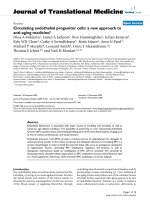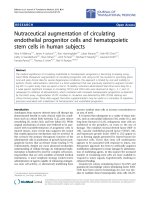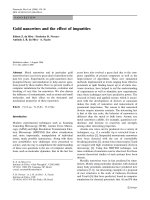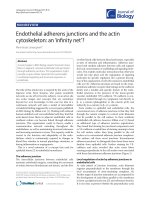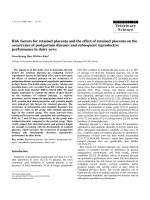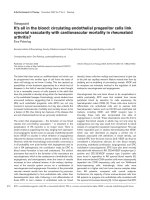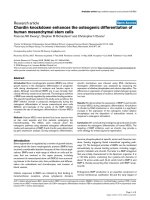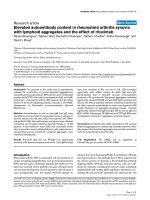Vascularised bone tissue engineering endothelial progenitor cells and human mesenchymal stem cells coculture in 3d honeycomb scaffolds and the effect of bi rotational bioreactor and hypoxic microenvironment 1
Bạn đang xem bản rút gọn của tài liệu. Xem và tải ngay bản đầy đủ của tài liệu tại đây (10.12 MB, 146 trang )
VASCULARISED BONE TISSUE ENGINEERING:
ENDOTHELIAL PROGENITOR CELLS AND HUMAN MESENCHYMAL STEM
CELLS COCULTURE IN 3D HONEYCOMB SCAFFOLDS AND THE EFFECT OF
BI-ROTATIONAL BIOREACTOR AND HYPOXIC MICROENVIRONMENT
LIU YUCHUN
B.Eng.(Hons), NUS
A THESIS SUBMITTED
FOR THE DEGREE OF DOCTOR OF PHILOSOPHY
DEPARTMENT OF MECHANICAL ENGINEERING
NATIONAL UNIVERSITY OF SINGAPORE
2012
i
Declaration
I hereby declare that this thesis is my original work and it has been written by me in
its entirety. I have duly acknowledged all the sources of information which have been
used in the thesis.
This thesis has also not been submitted for any degree in any university previously.
Liu Yuchun
18 December 2012
ii
Acknowledgements
It is a pleasure recalling the past few delightful years of my PhD journey as I pen
down the names of many people whom I would like to thank for making this PhD
thesis possible.
First and foremost, I owe my deepest gratitude to my two supervisors Prof Teoh
Swee-Hin and A/Prof Jerry Chan. I would like to thank them for their constant
sharing of knowledge and ideas, their patience and understanding, and the many
hours they have each dedicated to sit down with me in person to guide and advise
me in scientific thinking, planning, writing and making presentations. Their
supervision in combination was like the Yin and Yang put together that completed
me, developing me personally and scientifically. I am also indebted to them for the
many opportunities that they have laid out for my exploration during the time of my
PhD journey, exposing me to various aspects of research and the life of academia. It
was in their selflessness and enthusiasm that I found inspiration and encouragement
that stretched me beyond limits I never imagined I could achieve.
I am also grateful to Prof Mahesh Choolani and Dr Chui Chee Kong for their support
during my postgraduate studies, as well as many fellow colleagues especially Mark,
Citra, Yanti, Zhiyong, Sonia, Eddy, Niraja, Lay Geok, Daren, Priya, Aniza, Erin,
Zuyong, Qinyuan, Lim Jing, Wang Zhuo, Julie, Joan, Yiping, Chin Wen (and many
others!) for their camaraderie and advice – they have all been a great help to me. I
would also like to thank the administrative staff, Ms Sharen Teo (Mechanical
Engineering) and Ms Ginny Chen (Obstetrics & Gynaecology) laboratories for their
kind assistance these years.
iii
It has been a pleasure to work on a collaborative project under the guidance of Prof
Roger Kamm, who has made available his support in many ways. I am extremely
grateful to his kind supervisorship and the various opportunities he had provided me
with, allowing me great exposure to various research projects, discussions and ideas
outside of my scope of PhD work. It was also a great honour for me to work in his
laboratory in Massachussetts Institute of Technology. A big thank you to his
laboratory mates, especially Kenichi and Yannis, as well as the administrative staff
for providing such a stimulating and friendly working environment!
To the staff of the Cels Vivarium, especially Dr Enoka, Jeremy and James, thank you
for taking such great care of my experimental animals; To the NUHS delivery suite
for their assistance with sample collection; To the other collaborators whom I have
interacted with at Singapore-MIT Alliance for Research and Technology (the many
post-docs, graduate students and intern students!), Singapore Polytechnic and
QuinXell (especially Dr Lau, Mr Chong, Mr Foo, Yhee Cheng, Huilun and their FYP
students), my two RJC students Rebecca and Grace, thank you so much for your
kind assistance and friendship. To my undergraduate Bioengineering friends,
especially Xiuli, thank you for providing valuable advice and experimental help
whenever needed. My gratitude list continues to run long…
Most importantly, I would like to thank my family and Raye for their constant care
and love that I have felt in many ways; for their guidance, unwavering support, words
of wisdom and encouragement that kept me strong and motivated during both good
times and tough times. With gratitude and love, I dedicate this PhD thesis to them.
This work was funded National Medical Research Council of Singapore
(NMRC/1179/2008 and NMRC/1268/2010).
iv
Preface – International Publications, Conferences and Awards
Nothing is impossible, the word itself says “I’m Possible”!
~Audrey Hepburn
v
Preface – International Publications, Conferences and Awards
International Journal Publications
First-authorship
1. Yuchun Liu, Swee-Hin Teoh, Mark S K Chong, Eddy S M Lee, Citra N Z Mattar,
Nau’shil Kaur Randhawa, Zhi Yong Zhang, Reinhold J. Medina Benavente,
Roger D Kamm, Nicholas M Fisk, Mahesh Choolani, Jerry K Y Chan.
Vasculogenic and Osteogenesis-Enhancing Potential of Human Umbilical Cord
Blood Endothelial Colony-Forming Cells. Stem Cells. 2012 Sep;30(9):1911-24
- Featured Top Story in Cord Blood News, Connexon, July 2012
2. Yuchun Liu, Swee-Hin Teoh, Mark Chong, Chen-Hua Yeow, Roger D, Kamm;
Mahesh Choolani; Jerry K Y Chan. Enhanced Vasculogenic Induction Upon
Biaxial Bioreactor Stimulation of Mesenchymal Stem Cells and Endothelial
Progenitor Cells Cocultures in 3D Honeycomb Scaffolds for Vascularised Bone
Tissue Engineering. Tissue Engineering Part (A). 2012 Oct 26.
doi:10.1089/ten.TEA.2012.0187
3. Yuchun Liu, Jerry KY Chan, Swee-Hin Teoh. Review on Vascularised Bone
Tissue Engineering Strategies: Focus on Coculture Systems. Journal of Tissue
Engineering and Regenerative Medicine. 2012 Nov 19. doi:
10.1002/term.1617
4. Yuchun Liu and Swee-Hin Teoh. Development of Next Generation Scaffolds for
Successful Vascularised Bone Tissue Engineering. Biotechnology Advances.
2012 Nov 9. doi: 10.1016/j.biotechadv.2012.10.003
vi
Co-authorship
1. Ji-Hoon Bae, Hae-Ryong Song, Hak-Jun Kim, Hong-Chul Lim, Jung-Ho Park,
Yuchun Liu, Swee-Hin Teoh. Discontinuous release of Bone Morphogenetic
Protein-2 (BMP-2) loaded within interconnected pores of honeycombed-like
polycaprolactone scaffold promotes bone healing in a large bone defect of rabbit
ulna. Tissue Engineering Part (A). 2011 Oct;17(19-20):2389-97
2. Choong Kim, Seok Chung, Yuchun Liu, Min-Cheol Kim, Jerry K. Y. Chan, H.
Harry Asada and Roger D. Kamm. In vitro angiogenesis assay for the study of
cell encapsulation therapy. Lab on the Chip. 2012 Aug 21;12(16):2942-50
3. Kenichi Funamoto, Ioannis Zervantonakis, Yuchun Liu, Christopher Ochs,
Choong Kim, Roger Kamm. A Novel Microfluidic Platform for High-Resolution
Imaging of a Three-Dimensional Cell Culture under a Controlled Hypoxic
Environment. Lab on the Chip. 2012 Nov 21;12(22):4855-63
vii
Conferences and Meetings
Y Liu, WS Chong, TT Foo, YC Chng, MA Choolani, J Chan, SH Teoh. In vitro
maturation of large hfMSC-PCL/TCP bone tissue engineered construct through long
term culture in a biaxial perfusion flow bioreactor. Joint meeting: International
Conference on Materials for Advanced Technologies (ICMAT) and International
Union of Materials Research Societies – International Conference in Asia (IUMRS-
ICA), 28 June – 3 July 2009, Singapore.
Y Liu, SK Chong, Z Zhang, M Choolani, J Chan, SH Teoh. Generation of vascular
networks within osteogenic tissue engineered constructs through the coculture of
umbilical cord derived endothelial progenitor cells and fetal bone marrow derived
mesenchymal stem cells. 7
th
Singapore International Congress of O&G (SICOG), 26-
29 August 2009, Singapore.
Y Liu, SK Chong, Z Zhang, M Choolani, SH Teoh, J Chan. Generation of vascular
networks within bone tissue engineered constructs through the coculture of umbilical
cord derived endothelial progenitor cells and fetal mesenchymal stem cells. National
Healthcare Group (NHG) Annual Scientific Congress, 16-17 October 2009,
Singapore.
Attended 6
th
World Congress of Biomechanics (WCB), 1-6
August 2010, Singapore.
Attended Singapore-Australia Joint Symposium on Stem Cells and Bioimaging, 24-
25 May 2010, Singapore.
Y Liu, SH Teoh, SK Chong, Z Zhang, MA Choolani, J Chan. Human endothelial
progenitor stem cells accelerates and potentiates the osteogenic response of bone
marrow derived human fetal mesenchymal stem cells through paracrine signalling
mechanisms. International Society for Stem Cell Research (ISSCR), 16-19 June
2010, San Francisco, USA.
Attended Global Enterprise for Micro-Mechanics and Molecular Medicine (GEM4),
25-31 July 2010, Singapore.
Y Liu, SH Teoh, SK Chong, Z Zhang, M Choolani, J Chan. Human endothelial
progenitor stem cells enhances osteogenic response of bone marrow derived human
fetal mesenchymal stem cells through paracrine signalling mechanisms in vitro and
induces neovasculogenesis in vivo prior to bone repair. Tissue Engineering and
Regenerative Medicine International Society (TERMIS-AP), 15-17 September 2010,
Singapore.
Y Liu, J Chan, SK Chong, Z Zhang, MA Choolani, SH Teoh. Coculture of human
endothelial progenitor stem cells and bone marrow-derived human fetal
mesenchymal stem cells potentiates osteogenesis through paracrine activity in vitro
and induces neovasculogenesis within tissue engineered bone grafts in vivo.
International Bone-Tissue-Engineering Congress (Bone-Tec), 7-10 October 2010,
Hannover, Germany.
Y Liu, SH Teoh, SK Chong, Z Zhang, M Choolani, J Chan. Human endothelial
progenitor cells & bone marrow-derived human fetal mesenchymal stem cells
potentiate osteogenesis via paracrine activity & induce neovasculogenesis in tissue
engineered bone grafts. SingHealth Duke-NUS Scientific Congress, 15-16 October
viii
2010, Singapore.
Y Liu, SH Teoh, SK Chong, R Kamm, Z Zhang, M Choolani, J Chan. Role of EPC in
vascularised bone tissue engineering. International Society for Stem Cell Research
(ISSCR), 15-18 June 2011, Toronto, Canada.
Y Liu, J Chan, SK Chong, Z Zhang, M Choolani, SH Teoh. Cellular interactions of
endothelial progenitor cells and mesenchymal stem cells for vascularised bone
tissue engineering. Tissue Engineering and Regenerative Medicine International
Society (TERMIS-AP), 3-5 August 2011, Singapore.
Y Liu, SK Chong, SH Teoh, Z Zhang, M Choolani, J Chan. Role of EPC:
vasculogenic and osteogenic regulator of msc for bone tissue engineering. 8
th
Singapore International Congress of O&G (SICOG), 25-27 August 2011, Singapore.
Y Liu, SH Teoh, SK Chong, R Kamm, M Choolani, J Chan. Cellular interactions of
EPC with MSC: An osteogenic and vasculogenic enhancer for vascularised bone
tissue engineering. Stem Cell Biology, 20-24 September 2011, Cold Spring Harbour,
New York.
Y Liu, J Chan, SK Chong, Z Zhang, M Choolani, SH Teoh. Vascularised bone tissue
engineering using a coculture of endothelial progenitor cells and mesenchymal stem
cells. 3
rd
Asian Biomaterials Congress, 15-17 September 2011, Busan, Korea.
Y Liu, J Chan, R Kamm, SK Chong, M Choolani, SH Teoh. Revolutionary approach
to cell cultures: culturing fresh bone marrow aspirates in hypoxia enhances
osteogenic differentiation of human fetal mesenchymal stem cells. International
Bone-Tissue-Engineering Congress (Bone-Tec), 13-16 October 2011, Hannover,
Germany.
Y Liu, J Chan, R Kamm, SK Chong, M Choolani, Z Zhang, SH Teoh. Generating
Vascularised Tissue-Engineered Bone Grafts: Endothelial Progenitor Cells in
Vasculogenic and Osteogenic Priming of Human Fetal Mesenchymal Stem Cells.
International Bone-Tissue-Engineering Congress (Bone-Tec), 13-16 October 2011,
Hannover, Germany.
Y Liu, J Chan, R Kamm, SK Chong, M Choolani, SH Teoh. A coculture approach
towards increasing vascularisation in bone tissue engineered grafts. 4
th
International
Conference on the Development of Biomedical Engineering (BME4), Regenerative
Medicine Conference, 8-10 January 2012, Ho Chi Minh City, Vietnam.
Y Liu. Building vascularised bone tissue-engineered grafts. “Speak Out For
Engineering” by Institution of Mechanical Engineers (ImechE, Local Heats), 2
February 2012, Singapore.
Y Liu. Building vascularised bone tissue-engineered grafts. “Speak Out For
Engineering” by Institution of Mechanical Engineers (ImechE, Oceania and Asia
Regional Heats,), 21 April 2012, Singapore.
Y Liu, J Chan, R Kamm, SK Chong, M Choolani, SH Teoh. Revolutionary approach
to cell cultures: culturing fresh bone marrow aspirates in hypoxia enhances
osteogenic differentiation of human fetal mesenchymal stem cells. University
Obstetrics & Gynaecology Congress (UOGC), 25-27 May 2012, Singapore.
SK Chong, Y Liu
, Z Zhang, D Sandikin, C Mattar, M Choolani, J Chan. Human Fetal
ix
Mesenchymal Stem Cells and Endothelial Progenitor Cells for the Generation of
Engineered Bone Grafts: A Pre-clinical Study. University Obstetrics & Gynaecology
Congress (UOGC), 25-27 May 2012, Singapore.
Z Wang, Y Liu, WS Chong, TT F, SH Teoh. Enhanced osteogenesis of human
mesenchymal stem cells under the continuous compressive force by a novel biaxial
bioreactor system. World Biomaterials Congress (WBC), 1-5 June 2012, Chengdu,
China.
Y Liu, SH Teoh, SK Chong, MA Choolani, J Chan. Mimicking the bone-marrow
niche: continuous culture of fresh bone marrow aspirates in hypoxia enhances
osteogenic differentiation of human fetal mesenchymal stem cells. International
Society for Stem Cell Research (ISSCR), 13-16 June 2012, Yokohama Japan.
Y Liu, J Chan, SK Chong, M Choolani, SH Teoh. The importance of continuous
hypoxic exposure for the culture of human fetal mesenchymal stem cells in bone
tissue engineering applications. 3
rd
Tissue Engineering and Regenerative Medicine
International Society (TERMIS) World Congress, 5-8 September 2012, Vienna,
Austria.
K Funamoto, IK Zervantonakis, Y Liu, R Kamm. Oxygen Tension Control in a
Microfluidic Device for Cell Culture. 9
th
International Conference on Flow Dynamics
(ICFD), 19-21 September 2012, Sendai, Japan.
K Funamoto, IK Zervantonakis, Y Liu, CJ Ochs, R Kamm. Computational Simulation
to Create Low Oxygen Tension in a Microfluidic Device for Cell Culture. 9
th
International Conference on Flow Dynamics (ICFD), 19-21 September 2012, Sendai,
Japan.
Y Liu. Perfusion Biaxial Rotary Bioreactor for Vascularised Bone Tissue Engineering,
2012 Bioreactor & Growth Environments for Tissue Engineering Training Course, 5-7
November 2012, Keele, United Kingdom.
FS Goh, Y Liu, SH Teoh. Effect of Desferrioxamine on Cytocompatibility,
Angiogenesis and Bone Forming Ability of Mesenchymal Stem Cells. International
Conference on Cellular & Molecular Bioengineering (ICCMB3), 8-10 Dec 2012,
Singapore.
XY Lim, Y Liu, SH Teoh. Effects of Strontium on the Proliferation and Bone Forming
Capacity of Human Fetal Mesenchymal Stem Cells Seeded onto Scaffolds.
International Conference on Cellular & Molecular Bioengineering (ICCMB3), 8-10
Dec 2012, Singapore.
R Akhilandeshwari, Y Liu, J Lim, SH Teoh. Determination of Compressive Range of
Scaffolds for Bone Tissue Engineering in Biaxial Bioreactor. International
Conference on Cellular & Molecular Bioengineering (ICCMB3), 8-10 Dec 2012,
Singapore.
Y Liu, J Chan, SH Teoh. Vascularised Bone Tissue Engineering. International
Conference on Cellular & Molecular Bioengineering (ICCMB3), 8-10 Dec 2012,
Singapore.
x
Awards
2009 - Best Poster Award at ICMAT, Singapore
2010 - Top 10 selected Best Posters, Translational Research Category at
SingHealth Duke-NUS Scientific Congress 2010, Singapore
2010 - Best Poster Award at Bone-Tec, Hannover, Germany
2011 - Travel Award at ISSCR, Toronto, Canada
2011 - Best Young Scientist Award at Bone-Tec 2011, Hannover, Germany
2011 - World’s Fastest Cell at the 1st World Cell Race held at the American Society
for Cell Biology, Denver, Colorado.
Submitted the human fetal bone marrow derived mesenchymal stem cells on behalf
of the team, which came in first with a cellular speed record of 5.2 microns per
minute amongst 70 other submissions globally.
2012 - Travel Award at ISSCR, Yokohama, Japan
2012 - 1st Prize, “Speak Out For Engineering" Local Heats by Institution of
Mechanical Engineers
2012 - 2nd Prize, “Speak Out For Engineering" Regional Heats (Oceania and Asia)
by Institution of Mechanical Engineers
2012 - S Arulkumaran Young Investigator (Scientist) at University Obstetrics &
Gynaecology Congress 2012, Singapore
xi
Table of Contents
Declaration i
Acknowledgements ii
Preface – International Publications, Conferences and Awards v
International Journal Publications v
First-authorship v
Co-authorship vi
Conferences and Meetings vii
Awards x
Table of Contents xi
Summary xv
List of Tables xvi
List of Figures xviii
List of Symbols xxiv
Chapter 1 – Introduction 2
1.1 Bone Grafts and Current Unmet Needs 2
1.2 Non-union Fractures 2
1.3 Current Strategies for Bone Repair 3
1.3.1 Autologous Grafts 4
1.3.2 Allogenic Grafts 4
1.3.3 Synthetic Grafts 5
1.4 Bone Tissue Engineering 5
1.4.1 Limitations in Bone Tissue Engineering 6
1.5 Importance of Vascularisation 7
1.5.1 Vascularisation in Bone Tissue Engineering 7
1.5.2 Vascularisation in Natural Bone Repair Processes 8
1.5.3 Periosteum and Its Vasculature 9
1.6 Motivation of Study 10
1.7 Proposed Approach 11
1.7.1 Vascularised BTE – A Mimicry of Natural Bone Tissue 11
1.7.2 Aims and Hypotheses 12
1.7.2.1 Main Aim 12
1.7.2.2 Hypothesis 1 13
1.7.2.3 Hypothesis 2 13
1.7.2.4 Hypothesis 3 13
1.7.3 Novelty and Clinical Implications 13
Chapter 2 – Literature Review 16
2.1 The Skeletal System 16
2.2 Anatomy of Bone 16
2.3 Composition of Bone 18
2.3.1 Bone Cells 18
2.3.2 Bone Matrix 19
2.4 Natural Bone Forming Process 20
2.4.1 Endochondral Ossification 20
2.4.2 Distraction Osteogenesis 21
2.5 Physiological Microenvironment of Bone 22
2.5.1 Biomechanical Cues 23
2.5.2 Oxygen Tension Cues 24
2.5.3 Biochemical Cues 26
2.6 Bone Tissue Engineering 30
2.6.1 Four-Stage Bone Formation in Bone Tissue Engineering 30
2.6.2 Strategies in Bone Tissue Engineering 32
xii
2.6.2.1 Growth Factors Approach 32
2.6.2.2 Cell-Based Approach 34
2.7 Vascularisation Strategies in Bone Tissue Engineering 34
2.7.1 ‘Smart’-scaffolds and Growth Factors 36
2.7.2 Prevascularisation Techniques 37
2.7.2.1 In Vivo Prevascularisation 38
2.7.2.2 In Vitro Prevascularisation 38
2.8 Components of Bone Tissue Engineering 39
2.8.1 Scaffolds 40
2.8.1.1 Biomaterial Selection 42
2.8.1.2 Polycaprolactone 43
2.8.1.3 Tri-calcium Phosphate 44
2.8.1.4 Proposed Scaffold – Polycaprolactone/Tri-calcium Phosphate
Composite 44
2.8.2 Cellular Sources 46
2.8.2.1 Osteogenic Cells 46
2.8.2.2 Mesenchymal Stem Cells 48
2.8.2.3 Mesenchymal Stem Cells in Bone Tissue Engineering 49
2.8.2.4 Proposed Cell Type – Human Fetal Mesenchymal Stem Cells 50
2.8.2.5 Endothelial Cell Types 51
2.8.2.6 Endothelial Progenitor Cells 52
2.8.2.7 Endothelial Progenitor Cells in Fracture Healing 53
2.8.2.8 Proposed Endothelial Cell Type – Umbilical Cord Blood-Endothelial
Progenitor Cells 54
2.8.3 Bioreactor 56
2.8.3.1 Proposed Bioreactor – Perfusion Biaxial Bioreactor 57
2.8.4 Hypoxia in the Natural Physiology 60
2.8.4.1 Hypoxia and Mesenchymal Stem Cells 60
2.8.4.2 Hypoxia and Bone Repair 61
2.9 Coculture Systems 62
2.9.1 Trends in Coculture Systems 62
2.9.2 Cocultures in Vascularised Bone Tissue Engineering 63
2.9.3 Considerations for Coculture Systems 67
2.9.3.1 Choice of Media 67
2.9.3.2 Seeding Methodology 70
Chapter 3 - Materials and Methods 74
3.1 Samples, Animals and Ethics 74
3.2 Cells 74
3.2.1 Cell Isolation, Culture and Characterisation 74
3.2.1.1 Human Fetal Bone Marrow Derived Mesenchymal Stem Cells 74
3.2.1.2 Human Umbilical Cord Blood Derived Endothelial Progenitor Cells 75
3.2.2 Lentiviral-Transduction of hfMSC and EPC 76
3.3 Flow Cytometry 76
3.4 Multilineage Differentiation 77
3.4.1 Adipogenic Differentiation 77
3.4.2 Chondrogenic Differentiation 77
3.4.3 Osteogenic Differentiation 77
3.5 Preparation of EPC Conditioned Media 77
3.6 Osteogenic Assays 78
3.6.1 Calcium Assay 78
3.6.2 Alkaline Phosphatase Assay 78
3.6.3 Von Kossa Staining 78
3.7 Antibody Array and Microarray Scanning 79
3.8 Microarray Analysis of Gene Expression 79
3.9 Quantitative Polymerase Chain Reaction Analysis 80
xiii
3.10 Cellular Viability Assay 81
3.11 Growth Kinetics and Colony-Forming Unit-Fibroblasts Assay 81
3.12 Preparation of Cellular-Scaffold Constructs 82
3.12.1 Scaffold Fabrication and Treatment 82
3.12.2 Cell Loading 82
3.13 Bioreactor Setup 83
3.14 Imaging 83
3.14.1 Phase Contrast Light Microscopy 83
3.14.2 Confocal Microscope 84
3.14.3 Scanning Electron Microscope 84
3.14.4 Micro-Computed Tomography 84
3.15 Animal Work 84
3.15.1 Subcutaneous Implantations in Mice 84
3.15.2 Microfil Perfusion 85
3.15.3 Histology 85
3.15.3.1 Capillary Density Analysis 86
3.15.4 Immunohistochemistry 86
3.15.4.1 Human:Mouse Chimerism 86
3.15.4.2 Staining of CD31 Structures 86
3.15.4.3 Osteopontin Staining 87
3.15.5 Image Analysis 87
3.13.5.1 ImageJ Software 87
3.15.5.2 Imaris Software 87
3.16 Statistical Analysis 87
Chapter 4 – Coculture of Human Umbilical Cord Blood Endothelial Colony-Forming
Cells with Human Fetal Mesenchymal Stem Cells for the Generation of Vascularised
BTE Grafts 89
4.1 Abstract 89
4.2 Introduction 90
4.3 Experimental Approach 91
4.4 Results 91
4.4.1 Cell Characterisation 91
4.4.1.1 Human Fetal Mesenchymal Stem Cells 91
4.4.1.2 Endothelial Progenitor Cells 93
4.4.2 Optimal Media for Osteogenic Differentiation of Coculture In Vitro 94
4.4.3 Optimal Coculture Ratio for Osteogenic Differentiation In Vitro 96
4.4.4 Mechanism of Action of EPC for Osteogenic Potentiation 98
4.4.5 Identity of EPC Secretome 101
4.4.6 Osteogenic and Angiogenic Capacity of UCB versus PB-EPC 104
4.4.7 In Vitro Vessel Forming Ability of EPC/hfMSC Cocultures 106
4.4.8 In Vivo Vasculogenesis of EPC/hfMSC Cocultures 108
4.4.9 Ectopic Bone Forming Ability of EPC/hfMSC Cocultures 112
4.5 Discussion 113
4.6 Conclusion 119
Chapter 5 – Dynamic Biaxial Bioreactor Culture for In Vitro Maturation of
Vascularised BTE Coculture Grafts 121
5.1 Abstract 121
5.2 Introduction 122
5.3 Experimental Approach 124
5.4 Results 124
5.4.1 Effect of Biaxial Bioreactor Culture on In Vitro Vessel Formation 124
5.4.2 Effect of Biaxial Bioreactor Culture on Mineralisation In Vitro 126
5.4.3 Effect of Biaxial Bioreactor Culture on Bone Formation and
Vasculogenesis In Vivo 128
xiv
5.4.4 Effect of Biaxial Bioreactor Culture on Cell Viability and Human:Mouse
Chimerism 130
5.5 Discussion 131
5.6 Conclusion 135
Chapter 6 – Culture Methodologies of hfMSC Under Hypoxia for the Enhancement of
Growth Kinetics and Osteogenic Differentiation 137
6.1 Abstract 137
6.2 Introduction 138
6.3 Experimental Approach 139
6.4 Results 140
6.4.1 Effect of Hypoxia
short-term
on hfMSC Growth Kinetics 140
6.4.2 Effect of Hypoxia
short-term
on the Osteogenic Differentiation of hfMSC 141
6.4.3 Effects of Hypoxia
precondition
on Retaining hfMSC Properties 144
6.4.4 Ex Vivo Expansion in Hypoxia
continuous
on hfMSC Growth Kinetics 146
6.4.5 Ex Vivo Expansion in Hypoxia
continuous
on the Osteogenic Differentiation of
hfMSC 147
6.5 Discussion 148
6.6 Conclusion 152
Chapter 7 – Conclusion, Considerations and Future Work 154
7.1 Conclusion 154
7.2 Considerations and Future Work 155
7.2.1 Cells: Improving Expansion and Differentiation via Hypoxic Isolation Methods
156
7.2.1.1 Endothelial Progenitor Cells 156
7.2.1.2 Human Fetal Mesenchymal Stem Cells 161
7.3.1 Cocultures and their Mechanisms 162
7.3.2 Cocultures in Hypoxia 163
7.3.3 Coculture Patterning via Bioprinting 163
7.4 Bioreactor Development and Optimisation 165
7.4.1 Optimisation of Timing of Biomechanical Exposure 165
7.4.2 Scale-Down Bioreactors 165
7.4.3 Introduction of Low Oxygen Tensions into Bioreactor 166
7.5 Imaging Tools: High Resolution Tracking of Vessel and Bone Formation 167
7.5.1 In Vivo Time-Lapse Tracking in Animal Models 167
7.5.2 In Vitro Studies in Microfluidic Devices 168
7.6 Clinical Feasibility 169
7.6.1 Large Orthotopic Animal Models 169
7.6.2 Cord Blood Banking 170
7.7 Regulatory Approval for Clinical Translation 170
Bibliography 173
Appendix 189
xv
Summary
Poor angiogenesis impairs bone regeneration, limiting the clinical translation of bone
tissue engineered (BTE) grafts for the repair of large defects. In this project,
vasculogenic endothelial progenitor cells (EPC) cocultured with osteogenic human
fetal mesenchymal stem cells (hfMSC) potentiated its osteogenic differentiation in
vitro through paracrine signalling and formed an in vitro vascular network in the three
dimensional honeycomb polycaprolactone/tri-calcium phosphate composite scaffolds.
Upon subcutaneous implantation, EPC/hfMSC showed enhanced vascularity and
consequentially, improved osteogenicity in vivo. Biomechanical stimulation of
EPC/hfMSC-grafts in a biaxial bioreactor resulted in increased cell viability, more
robust bone formation and increased vasculogenesis compared to its implanted
static-cultured coculture. In addition, the maintenance of hfMSC under continuous
hypoxic microenvironment upon cell isolation demonstrated enhanced colony-
forming ability and osteogenic potential. This thesis explores the use of a coculture
of stem cells, in conjunction with bioresorbable scaffolds, bioreactor technologies
and a low oxygen microenvironment for the generation of voluminous bone grafts
that are capable of rapid vascularisation for facilitating bone repair.
xvi
List of Tables
Table 1-1
Characteristics of the different types of non-union fractures include
avascular and vascular non-unions.
Table 1-2
Proposed BTE approach and the choice of each individual BTE
component, including the choice of cells, scaffolds, bioreactor and
microenvironment oxygen tensions.
Table 2-1
Endochondral ossification involves four main stages, namely the
inflammatory phase, soft callus fibrocartilageous formation, hard
callus formation and bone remodelling.
Table 2-2
The process of distraction osteogenesis involves three stages,
namely latency, distraction and consolidation.
Table 2-3
(A-B) Comparison between the natural fracture healing and
distraction osteogenesis processes and their various
microenvironmental cues that contribute to vascular and bone
formation, including the relative up and down expressions of
molecular regulators involved in various stages of bone repair and
distraction osteogenesis.
.
Table 2-4
Four-staged bone forming process relating to the structural bone, its
mechanical properties and vessel formation over time of healing; +
indicates the relative intensity.
Table 2-5
A summary of the advantages and disadvantages of in vitro and in
vivo prevascularisation strategies.
Table 2-6
Basic criteria and considerations when designing a scaffold for use in
BTE applications.
Table 2-7
PCL/TCP scaffold design and its characteristics as reported in
literature data.
Table 2-8
Comparison of different cellular sources, including MSC for their
potential in BTE applications.
Table 2-9
Summary of the main characteristics of mature endothelial cells and
its progenitor cells.
Table 2-10
Comparison between UCB and adult PB-EPC in terms of its colony
emergence, growth and vessel forming ability.
Table 2-11
Comparison of the advantages and disadvantages of the various
modes of commonly used bioreactors.
Table 2-12
(A-B) Citation analysis on the utility of cocultures in tissue
engineering and bone tissue engineering respectively, as well as the
leading institutions and experts.
Table 2-13
Summary of various animal models used for implantation of
coculture systems in vascularised BTE. * Denotes an orthotopic
xvii
implantation in the animal model
Table 2-14
Maintenance of coculture systems in BTE, including media used,
coculture ratios and the seeding methodology, with coculture in
direct contact unless otherwise stated.
Table 2-15
Advantages and disadvantages of various seeding methodologies of
cocultures in vascularised BTE.
Table 4-1
The different media types and their respective constituents are used
for identifying the optimal media for directing osteogenic
differentiation of the coculture.
Table 4-2
(A) Top highest concentration of proteins found within EPC
CM
, of
which angiogenic cytokines and other (B) bone related morphogens
belonging to the TGF-β superfamily are featured prominently.
Table S1
(A-B) Top 10 most highly expressed osteogenic and angiogenic
genes in EPC (n=3 biological replicates) which were expressed in
fold terms over the median gene expression (median gene
expression = 4.59) include members of the TGFβ family such as
SMAD1,2,3 and 5, IL6 and the secreted osteogenic stimulants BMP
1,2,4,6,7,8).
Table S2
Microarray data for upregulated osteogenic genes above median
value of 4.59, along with relevant heat map colour indicator.
Table S3
Microarray data of upregulated angiogenic genes above median
value of 4.59, along with relevant heat map colour indicator.
Table S4
Human Cytokine Antibody Array and its normalised values against
the positive control, a biotinylated protein as indicated by the
manufacturer.
Table S5
Osteogenesis Genes (shown for 1 UCB x 3 PB), fold difference
between UCB-EPC and PB-EPC (n=3), LN2 Values given for UCB
and PB-EPC.
Table S6
Angiogenesis Genes (shown for 1 UCB x 3 PB), fold difference
between UCB-EPC and PB-EPC (n=3), LN2 Values given for UCB
and PB-EPC.
xviii
List of Figures
Figure 1-1
Four key technologies used in tissue engineering include cells and
their biomolecules, scaffolds, bioreactors and imaging tools.
Figure 1-2
Graphical analysis of the total number of publications and citations
on BTE in the past 20 years (Web of Science, 2012).
Figure 1-3
Three-dimensional rendering of computed tomography scans. (A)
Mice femurs showed impairment of fracture repair upon soluble,
neutralising VEGF receptor (Flt-IgG) treatment as compared to its
controls after 7 days. Callus (blue) and cortical bone (peach). (B)
VEGF stimulated repair of a rabbit segmental defect upon
exogenous VEGF-treatment (250µg) compared to its placebo on 28
days.
Figure 1-4
Vascularisation as a key component for successful BTE as well as
other areas of tissue engineering where vascularisation is needed.
Figure 2-1
Anatomy of the long bone and microstructure of vascularised bone
tissue and the comparative porosity of compact bone and spongy
bone.
Figure 2-2
A schematic of the hierarchical structure of bone from a sub-
nanostructure of collagen molecules to a nanostructure of
cylindrically arranged microfibrils to lamellar layers forming the
macrostructure of cortical bone.
Figure 2-3
Vascularised bone anatomy and microenvironmental influences such
as biomechanical, microarchitectural and low oxygen tension cues.
Figure 2-4
(A) Under hypoxic conditions, the HIF-1α subunit accumulates and is
stabilised, allowing it to translocate into the nucleus for dimerisation
with the HIF-1β subunit, forming the HIF-1 complex. This initiates the
upregulation of several angiogenic genes and secretion of growth
factors. Figure reproduced from Carmeliet and Jain (Carmeliet and
Jain 2000). (B) Sprouting of the endothelial cells is induced, resulting
in tip cells migrating towards the hypoxic stimulus, with stalk cells
following behind. New vascular network forms with the emergence of
various branch points overtime.
Figure 2-5
Growth factor delivery systems and their various entrapment
methodologies. Non-covalent strategies include (A-C) physical
entrapment released by diffusion with or without degradation of
delivery system (D-E) adsorption through physiochemical
interactions with material or receptor-proteins (F) ion complexation of
growth factors with oppositely charged molecules or via (G) covalent
means through direct coupling or via a bifunctional linker.
Figure 2-6
Conceptual illustration of cell viability and cell death within the thick
scaffold graft towards its core where cells are found more than
200µm away from the blood vessel supply.
xix
Figure 2-7
Diagrammatic representation of porous scaffold constructs (A)
encapsulated with growth factors and its time-dependent control
release (B) surface functionalised with growth factors either via
physical adsorption or covalent immobilisation methods.
Figure 2-8
An example of an in vivo prevascularisation technique. The implant
is grown inside the latissimus dorsi muscle, followed by subsequent
transplantation in the mandible.
Figure 2-9
Graphical representation of the molecular weight loss of the 3D
scaffold with respect to the growth and remodelling of the tissue-
engineered constructs over time.
Figure 2-10
Illustration of a scaffold with a trabecular-like honeycomb structure
and high porosity that allows for vascular infiltration, mass transport
and new tissue formation. (Right-hand image) Scanning electron
microscopy shows a honeycomb polycaprolactone/tri-calcium
phosphate scaffold, with an average pore size within the range of
500µm.
Figure 2-11
Micro-computed tomography imaging of PCL/TCP composite
scaffold showing fine TCP granules interspersed randomly within the
polymer matrix.
Figure 2-12
The process of mesengenesis illustrates the ability of MSC to
undergo defined differentiate into various cellular lineages, including
bone.
Figure 2-13
hfMSC constructs showed formation of an extensive vasculature
network with functional union repair after 12 weeks as compared to
little vasculature in the defect region of acellular constructs.
Figure 2-14
Mechanisms of angiogenesis and vasculogenesis. (a) Sprouting
angiogenesis from a pre-existing vessel through the secretion of
matrix metalloproteases that degrade the vascular basement
membrane, allowing endothelial cells to migrate and form a new
vessel branch. (b) EPC forms a vascular plexus, deposits matrix and
forms a lumen resulting in the formation of immature capillaries.
Figure 2-15
The perfusion biaxial bioreactor has two rotational axes (indicated by
blue block arrows), with scaffolds pinned and fixed in place while the
bioreactor rotates.
Figure 3-1
(A) Macroscopic view and (B) SEM imaging of the PCL/TCP
scaffolds shows a high porosity with an approximate pore size of
500µm and honeycomb microarchitecture.
Figure 3-2
The perfusion biaxial bioreactor has two rotational axes (indicated by
pink block arrows), with scaffolds pinned and fixed in place while the
bioreactor rotates.
Figure 3-3
Diagrammatic representations of scaffold-constructs upon
subcutaneous implantations at the dorsal surface of the NOD/SCID
mice.
Figure 4-1
(A) hfMSC had a spindle-like morphology and underwent tri-lineage
xx
differentiation. This was confirmed by Oil-red-O staining for
intracytoplasmic vacuoles of neutral fat; Alcian Blue staining showed
the presence of glycosaminoglycan in cartilages upon culture in a
micro-mass pellet form; von Kossa stains (black) for extracellular
calcium deposition. (B) Immunophenotypic characterisation of
hfMSC using flow cytometry showed high expression of MSC
markers such as (A-C) CD73, CD90, CD105 and did not express
hematopoietic and endothelial markers such as (D-F) CD14, CD34
and CD45.
Figure 4-2
Characterisation of UCB-EPC. (Top row from left to right) PCLM of
EPC demonstrated typical cobblestone morphology of endothelial
cells. EPC differentiated and formed networks when plated on
Matrigel. Immunostaining demonstrated expression of (Bottom row
from left to right) CD31, von Willebrand Factor, acLDL uptake (red)
and VE Cadherin, indicating endothelial phenotype and function. Cell
nuclei were counterstained with PI (red) and DAPI (blue) accordingly.
Figure 4-3
BM is necessary to induce osteogenic differentiation of hfMSC. (A)
hfMSC laid down extracellular minerals when cultured in BM, while
cell debris was observed with EPC in BM. Cells cultured in EGM10
and b-EGM10 did not demonstrate mineralisation. (B) hfMSC
cultured in BM showed dark Von Kossa stains for calcium crystals
but none in the other study groups. (C) This was confirmed by
quantitative calcium assays with only hfMSC grown in BM laying
down significant amounts of calcium. All assays were performed on
Day 14.
Figure 4-4
EPC/hfMSC in coculture induces earlier osteogenic differentiation of
hfMSC. (A) EPC/hfMSC groups in varying ratios displayed earlier
mineralisation compared to EPC and hfMSC monocultures. (B)
Quantitative ALP measurements with EPC/hfMSC (1:1)
demonstrated the earliest ALP peak activity on Day 7. (C)
EPC/hfMSC (1:1) cocultures laid down the most calcium on Day 14.
“***” (p<0.001).
Figure 4-5
Dose dependent effect of soluble factors in EPCCM enhanced
osteogenic differentiation of hfMSC. (A) hfMSC cultured in EPCCM
(1:1) and EPCCM (1:10) demonstrated earlier and more extensive
mineralisation than when cultured in BM. (B) Greater Von Kossa
staining were observed in EPCCM (1:1) and EPCCM (1:10)
compared to BM at Day 14 of osteogenic differentiation. (C) EPC
CM
(1:1)
and EPC
CM
(1:10)
displayed higher (2.2 fold and 1.8 fold
respectively) peak of ALP activity than BM. (D) Calcium deposited in
EPC
CM
(1:1)
and EPC
CM (1:10)
was consistently higher (1.5 fold and 1.4
fold respectively) than BM in all time points. (E) ALP levels were
consistently higher in BM than in basal media, D10, with the
coculture displaying highest levels on Day 14. (F) Both hfMSC and
EPC/hfMSC cocultures required osteogenic supplements to induce
osteogenic differentiation, which was potentiated with coculture, with
deposition of calcium after 14 days of induction, further confirmed by
Von Kossa staining (G). “***” (p<0.001)
Figure 4-6
Semi-quantitative analysis of EPC
CM
using the Human Cytokine
Antibody Array, where 118 secreted proteins found within EPC
CM
.
xxi
Figure 4-7
UCB versus adult PB-EPC taken from Medina et al (Medina et al.
2010) demonstrated higher expression levels of key osteogenic and
angiogenic genes using (A) Transcriptomic microarray analysis and
(B) qPCR.
Figure 4-8
EPC potentiate osteogenic programming of hfMSC and in vitro
tubule formation in the presence of bone inducing components (A)
GFP-labelled EPC showed better survival when cultured in BM than
in D10. (B) Coculture of GFP-EPC and H2B-RFP-hfMSC (Red
fluorescence nuclear staining) resulted in the formation of EPC islets
(white arrowheads), leading eventually to the development of tubular
structures (yellow arrows) by Day 7 (C) Formation of GFP-EPC
vessel-like structures with complex branching points was observed
when EPC/hfMSC were cocultured over 14 days within a 3D culture
system within a macroporous scaffold.
Figure 4-9
In vivo neovasculogenesis and ectopic bone formation. A) Increased
vascularisation of the EPC/hfMSC scaffolds evident three weeks
after implantation, as seen after Microfil perfusion (blue vessels). (B)
At eight weeks, human blood vessels stained with human specific
CD31 (green) were seen coursing through EPC/hfMSC scaffolds but
not hfMSC scaffolds. These human vessels can be seen enmeshed
with murine vessels (stained red with murine CD31 antibody) as
evident in a 50 µm section [merged and stacked confocal images
(C)]. EPC/hfMSC scaffolds contained a 2.2 fold (p=0.001) higher
density of host-derived murine-CD31 positive vessels (red)
compared to hfMSC scaffolds (arrows indicating area of human-
murine vasculature junctures) (D), while human vessels constituted
30.2% of the total vessel area within the construct (E). (F)
Immunostaining with human Lamins A/C demonstrated high levels of
chimerism in both scaffolds, with a trend towards lower human cell
chimerism in EPC/hfMSC scaffolds compared with hfMSC scaffolds.
Figure 4-10
(A-B) Von Kossa staining of the implants showed darker level of
staining (Scaffold regions has been denoted as S) and a slightly
higher level of calcium deposited in EPC/hfMSC scaffolds compared
to hfMSC scaffold. “*” (p<0.05)
Figure 5-1
(A) Vessel-like networks were formed only under static conditions of
both 2D (white arrows) and 3D cultures on Day 7, but not in dynamic
bioreactor cultures or when EPC were cultured alone. (B-C) An
extensive in vitro vessel network was formed in the statically-cultured
EPC/hfMSC cocultures which were observed to increase with
scaffold depth on Day 7.
Figure 5-2
Dynamic bioreactor culture of EPC/hfMSC-constructs induced
greater mineralisation compared to static culture. (A) Higher levels of
mineralisation were observed within the pores of dynamically-
cultured scaffolds by PCLM on Day 14. SEM also showed more
prominent network of extracellular matrix formation. (B) Dynamically-
cultured constructs showed 1.7 fold higher levels of calcium
deposited across all time points compared to static culture (p<0.001).
(C) FDA/PI staining of EPC/hfMSC cocultures were seen to maintain
a high level of viability in both static and dynamic culture as indicated
by the live:dead cell ratio (green:red) on Day 14.
xxii
Figure 5-3
Dynamic bioreactor culture induced greater vascularisation and new
bone formation in implanted EPC/hfMSC-constructs as compared to
statically-cultured constructs. (A) Masson’s Trichrome staining
showed denser and more compact tissue formation, with greater
number of capillary structures containing red blood cells (black
arrows) in the core of dynamically-cultured sections on Week 4.
Higher levels of pre-mineralising collagen (blue stains) with perfused
luminal structures are found at the edges of the scaffold, with
capillary density 1.2 and 2.3 fold higher than static and acellular
groups respectively (p>0.05; p<0.01) (B) Micro-CT analysis of the
scaffold volume showed presence of a capillary network formation
within the central pores of dynamically-cultured scaffolds as
compared to static and acellular scaffolds on Week 8, which showed
no observable differences (C) Von Kossa staining showed greater
regions of ectopic mineralisation (black stains inducated by white
arrows; scaffolds were indicated by ‘S’) and a larger area of rabbit
anti-human osteopontin staining in dynamically-cultured constructs
compared to static-constructs on Week 8.
Figure 5-4
Confocal imaging of histological sections showed 1.4 fold (p<0.001)
higher human:mouse chimerism upon anti-human lamins A/C
staining on Week 8.
Figure 6-1
(A-B) Growth kinetics of hfMSC showed higher cell proliferation upon
2% O
2
culture, with 1.4 fold higher cell numbers on Day 6 and 4.0
fold higher CFU-F capabilities on Day 14 (p<0.01) when cultured in
2% O
2
compared to 21% O
2
.
Figure 6-2
Osteogenic differentiation capabilities of hfMSC cultured in 2% and
21% O
2
. (A) Light microscopy images of mineral deposition showed
inhibition in 2% O
2
compared to 21% O
2
cultures, (B) with 3.1 fold
lower calcium deposition on Day 14 (p<0.001).
Figure 6-3
In vivo subcutaneous mice studies of hypoxia
short-term
-treated hfMSC
constructs for 2 days (A) Human specific Lamins A/C staining
showed no significant differences in hfMSC viability in both groups
on Week 8 (p>0.05). (B) Murine specific CD31 staining showed slight
increase in angiogenic potential in hypoxia compared to normoxia-
cultured scaffolds on Week 8 (p>0.05). (C) Masson’s Trichrome
staining showed new bone formation around the periphery of the
pores of the hypoxic cultured scaffolds, with the presence of dense
pre-mineralising collageneous tissue as compared to normoxia-
cultured scaffolds on Week 8.
Figure 6-4
(A) Cell proliferation assay showed highest proliferation in hypoxia,
which dropped to a level comparable to normoxic cultures upon
switching from 2% to 21% O
2
. (B) Photographs of crystal violet-
stained colonies of hfMSC cultured under 2% and 21% O
2
, with and
without O
2
switching at different time points.
Figure 6-5
(A) Photographs of crystal violet stained hfMSC colonies for different
gestational samples, seeded at different MNC densities and stained
at different time points as indicated (n=3), found to be 6.5 fold higher
under continuous hypoxia exposure (n=1; p<0.05). (B) Cell
xxiii
proliferation assay of hfMSC showed similar proliferative capacity in
the first 6 days of culture (n=1).
Figure 6-6
(A-B) Osteogenic assays of fresh BM-aspirates cultured in 2% and
21% O
2
. Light microscopy images show greater mineralisation, with
2.9 fold higher calcium deposition in continuous 2% O
2
compared to
21% O
2
on Day 14 (p<0.001) (n=1).
Figure 7-1
Future work for the development of current coculture systems will
encompass the four key technologies in tissue engineering, including
cells and their biomolecules, scaffolds, bioreactors and imaging
tools.
Figure 7-2
Earlier emergence of EPC colonies formed by Day 10 under
continuous hypoxic conditions, with none observed under normoxia
(B) Cell proliferation assay of EPC showed 1.3-1.8 fold higher
proliferative capacity in the first 7 days of culture.
Figure 7-3
(A, C) Experimental work-flow of cellular-treatment before and during
Matrigel assay and (B, D) quantification of quantification of branch
points of vessel networks formed. (B) HUVEC cultured in 2% O
2
during differentiation on Matrigel showed highest in vitro vessel-
forming ability, exhibiting 7.1-13.3 fold higher branch points than
when in 21% O
2
(p<0.001). No significant difference was noted when
cells were preconditioned before being laid onto Matrigel (D)
Untreated cells incubated in hypoxia during differentiation overnight,
resulting in 1.7 fold higher branch points formation (p<0.001).
xxiv
List of Symbols
2D Two-dimensional
3D Three-dimensional
AAALAC
Association for Assessment and Accreditation of Laboratory Animal
Care
DiI acLDL DiI complex acetylated Low Density Lipoprotein
ALP Alkaline Phosphatase
ANOVA Analysis of Variance
BESTT BMP-2 Evaluation in Surgery for Tibial Trauma
BM Bone Media
BM-MSC Bone-marrow derived MSC
BMP Bone Morphogenetic Protein
BSA Bovine Serum Albumin
BTE Bone Tissue Engineering
cDNA complementary Deoxyribonucleic Acid
CFU-F Colony-Forming Unit-Fibroblasts
cGMP Current Good Manufacturing Practices
CM Conditioned Media
CO
2
Carbon Dioxide
CSD Critical-Sized Defect
DAPI 4',6-diamidino-2-phenylindole
DMEM Dulbecco's Modified Eagle's Medium
EC Endothelial Cell
ECM Extracellular Matrix
EGF Endothelial Growth Factor
EGM Endothelial Growth Media
EPC Endothelial Progenitor Cell
ESC Embryonic Stem Cell
FBS Fetal Bovine Serum
FDA Fluorescein Diacetate
FGF Fibroblast Growth Factor
GCOS GeneChip Operating Software

